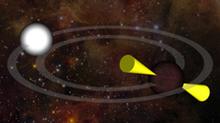Einstein@Home project detects unusual stellar pair
07 Apr 2011
Neutron stars are quite unique: the material they are made of is packed much more densely than conventional matter. They rotate extremely fast about their own axis, emitting radiation in the process, so they are often visible as pulsars in the radio spectrum.
 |
| Orbiting around a common centre of gravity: This simulation shows the orbits of pulsar J1952+2630 and its companion, presumably a white dwarf. The orbits are virtually circular, they only appear to be elliptical due to the viewing angle. The mass of the white dwarf, at 95 per cent of that of our Sun, is unusually high for such a binary system. © AEI |
Researchers at the Max Planck Institute for Gravitational Physics in Hanover, working as part of the international PALFA Collaboration, and with the help of participants in the Einstein@Home project, have now discovered a pulsar accompanied by a white dwarf – a burnt-out star. The researchers want to weigh the pair, using what is known as the Shapiro effect.
When faced with tricky questions relating to the general theory of relativity, scientists usually look in the universe for answers. Even then, it is often very difficult to filter out the right astrophysical objects from the plethora of data.
That is why scientists call on volunteers to help them in the time-consuming process of analysing data, making unused computing power on their home or office computers available for projects like Einstein@Home.
Armed with this support, the research group headed by Bruce Allen, director at the Max Planck Institute for Gravitational Physics (Albert Einstein Institute/AEI), Hanover, along with colleagues from the PALFA Collaboration, discovered radio pulsar J1952+2630.
The researchers found it in data from the Arecibo telescope. "I'm very excited that the Einstein@Home team has discovered another exotic radio pulsar. These amazing objects are so extreme that if they were crushed to one-third of their size, they would collapse to form black holes. And a big ,thank you` to our thousands of volunteers: we'd be nowhere without their contributions," says Allen.